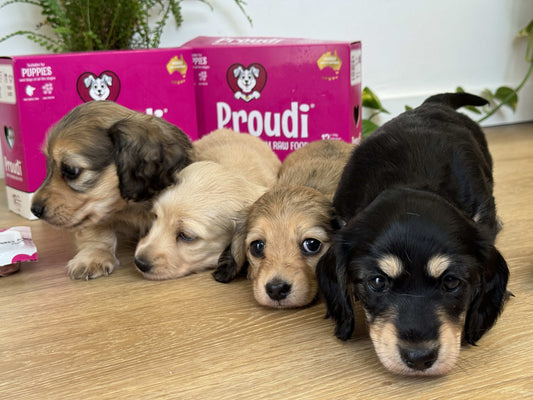
Transitioning your Dog or Cat to a Raw Diet
Transitioning your dog or cat to a raw diet is easy. Depending on the individual animal, it may require some persistence. Though it’s nothing you can’t manage with a simple transition schedule.
What to Expect in the Early Stages
When changing to a raw diet, your dog or cat may experience short term symptoms such as vomiting, diarrhea and/or constipation. These symptoms can be minimised and avoided with a slow transition, and by supplementing probiotics, such as kefir, throughout the transition period.
How to Transition
As a guide, we recommend the following transition schedule. Add Proudi to their previous diet at a ratio of 25:75 (raw food: previous food). Then, slowly increase the portion of Proudi and decrease the portion of their previous food.
The time frame may shorten or lengthen, depending on the individual animal and how they are taking to their new raw diet.
Cats Can be Particularly Fussy and Cautious of Change
The key is to be persistent and understand that caution and skepticism is simply in the nature of cats. Don’t be afraid to transition as slowly as your cat requires.
Still Have a Fussy Cat?
An alternate option for transitioning cats who are particularly resistant is to use the two-bowl technique. Provide your cat with 2 bowls at meal times- one containing the food they’re used to, the other containing their new raw food. Portion the food using similar ratios as the transition guide above, but separated into two bowls. Then follow the transition schedule as above, using the two bowls. If your cat doesn’t eat their raw food at all initially, lessen the portion in that bowl next time, and ensure you discard it after around 20 minutes, as it will start to spoil at room temperature.
An easy transition to a raw diet is one where you know what to expect for your dog or cat. Persist slowly through any resistance to change, and allow their bodies to adjust to each stage of the transition.
Remember that you’re doing it for the benefit of your dog or cat and their health, happiness and longevity.
What to Expect with a Successful Transition
Before you begin to notice the benefits of raw feeding, you may encounter some changes that leave you unsure about what’s normal. The first major change you can expect will be your pet’s stools. As mentioned previously, some diarrhoea and/ or vomiting for a day or so may occur (but can by minimised). After this, however, you will notice a significant decrease in size and regularity of stools. They will also be quite hard, making them quick to biodegrade and easy to pick up.
Dogs and Cats Usually Drink Less Water on a Raw Diet
A prey model raw diet is far more hydrating and can contain upwards of 65% moisture. However, continue to ensure they have plenty of clean water available to them at all times. They will still need to drink, but the rate at which they do so may slow down.




